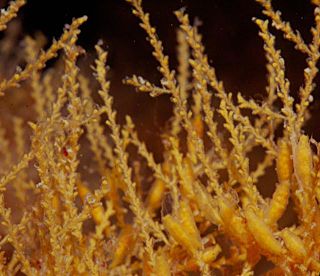
Rhodomelaceae is estimated to be the largest red algae family, with about 125 genera and over 700 species.

Jean Vincent Félix Lamouroux was a French biologist and naturalist, noted for his seminal work with algae.

Holaxonia is a suborder of soft corals, a member of the phylum Cnidaria. Members of this suborder are sometimes known as gorgonians and include the sea blades, the sea fans, the sea rods and the sea whips. These soft corals are colonial, sessile organisms and are generally tree-like in structure. They do not have a hard skeleton composed of calcium carbonate but have a firm but pliable, central axial skeleton composed of a fibrous protein called gorgonin embedded in a tissue matrix, the coenenchyme. In some genera this is permeated with a calcareous substance in the form of fused spicules. Members of this suborder are characterized by having an unspiculated axis and often a soft, chambered central core. The polyps have eight-fold symmetry and in many species, especially in the families Gorgoniidae and Plexauridae, contain symbiotic photosynthetic algae called zooxanthellae. These soft corals are popular in salt water aquaria.

Jania is a genus of red seaweeds with hard, calcareous, branching skeletons in the family Corallinaceae. Members of the genus are found in sheltered reef habitats, often in crevices or other shaded areas.

Plexauridae is a family of marine colonial octocorals in the phylum Cnidaria. Members of this family are found in shallow tropical and subtropical seas. Many species contain symbiotic photosynthetic protists called zooxanthellae.

Sertularella is a genus of hydroids in the family Sertulariidae.

Flustridae is a family of bryozoans in the suborder Flustrina.
Protomonaxonida is an extinct order of sea sponges. It is a paraphyletic group gathering the most ancient species from the Burgess Shale to modern sponges.

Sertularella gayi is a branching colonial hydroid in the family Sertulariidae.
Lafoeidae is a family of hydrozoans.

Coeloptychium is an extinct genus of lychniscosidan hexasterophoran sea sponge which has often been used as an index fossil. Its remains have been found in Cretaceous sediments in Germany, Belgium, France and the UK. Coeloptyhcium is best preserved in Campanian sediments in Germany. The type species, C. agaricoides, was named in 1826.

Euretidae is a family of glass sponges in the order Sceptrulophora.
Chorizopora is a genus of bryozoans belonging to the family Chorizoporidae.
Hippothoidae is a family of bryozoans belonging to the order Cheilostomatida.

Theonellidae is a family of sponges belonging to the order Tetractinellida, which was first described by Robert von Lendenfeld in 1903.
Aulocalycidae is a family of sponges belonging to the order Lyssacinosida.
Bereniceidae is a family of bryozoans belonging to the order Cyclostomatida.
Entalophora is a genus of bryozoans belonging to the family Entalophoridae.
Hippothoa is a genus of bryozoans belonging to the family Hippothoidae.
Idmonea is a genus of bryozoans belonging to the family Idmoneidae.











